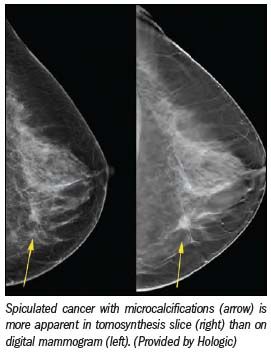Breast tomosynthesis gets ready for U.S. market
Breast tomosynthesis in the U.S. may finally be at hand. In September the FDA's Radiological Devices Panel unanimously agreed that Hologic's digital mammography tomosynthesis system, Selenia Dimensions, is effective and safe.
Breast tomosynthesis in the U.S. may finally be at hand. In September the FDA's Radiological Devices Panel unanimously agreed that Hologic's digital mammography tomosynthesis system, Selenia Dimensions, is effective and safe. A follow-up meeting between Hologic and the FDA identified several issues that need to be addressed, but none is expected to delay the process unreasonably, said Arthur Friedman, a Hologic senior vice president in charge of regulatory, clinical, and quality issues.
If all goes according to Hologic's plan, its 3D digital mammography system could be on the U.S. market within six months.
The few “housekeeping” issues Hologic has to take care of, Friedman said, have to do with making sure all questions about the company's premarket approval (PMA) have been answered. The one not-so-mundane task will be coming up with a training program for radiologists unfamiliar with breast tomosynthesis.

Before tomosynthesis, radiologists had to mentally triangulate 2D images, said Dr. Emily Conant, a professor of radiology at the University of Pennsylvania Medical Center in Philadelphia.
“Tomosynthesis allows us to scroll through the breast to see in-plane imaging at various depths,” she said. “With this we can find lesions that potentially we couldn't see before, or explain away pseudolesions that would otherwise be false positives.”
But lesions will look different, she said. That's where vendor training comes in.
Vendors must also play a role in the development of new technologies to help interpret tomo images, according to Conant. Postprocessing algorithms, similar to those used today in computer-aided detection, might help. instead of identifying suspicious lesions, as the current generation of CAD does, future algorithms might present the images in ways best suited to interpretation.
But even without CAD, radiologists will be working from a familiar base. Tomo will complement, not replace, 2D digital mammography. Hologic's PMA submission is based on data from multicenter clinical trials indicating that cancer is easier to spot when interpreting a combination of 3D and 2D views than when looking at 2D images alone. The combination also promises to reduce recall rates.
Not addressed in the clinical trials is productivity. Capturing and interpreting 2D and 3D images could slow the diagnostic process. Conant said that tomo may prolong readings, but only until the protocols for its use are optimized.
“We all complained about digital (when it was first introduced) and having to window and level and mag. But we learned pretty quickly and the industry worked with us to create navigational tools that made it more user-friendly,” she said. “So I am not worried about the additional time, because mostly it is a learning curve.”
Who will undergo tomo and for what reasons must still be determined. Conant believes tomo has a place in screening as well as diagnosis, but that must still be worked out.
Another issue is patient x-ray dose. This can be mitigated by optimizing the number of images taken, how the images are presented, and, through experience, figuring out the benefits to be gained from using tomo versus projection, she said, so tomo is used only when needed.
Finally there is the issue of reimbursement. The first Selenia Dimensions sold for tomosynthesis, if approved by the FDA, will arrive at U.S. sites before reimbursement for its use. This is common with new equipment. And Selenia Dimensions has an advantage in that, pending any special reimbursement for 3D, it can be used just for 2D.
Some U.S. radiologists are already doing that. Hologic has been selling its Dimensions product configured for 2D operation with the idea that a simple upgrade will make these installed systems 3D-ready once the FDA has approved the product for this application.
“This is really the beginning,” Conant said. “We don't yet know exactly how to use (tomosynthesis) or how to optimize it. There's a lot of work that needs to be done.”